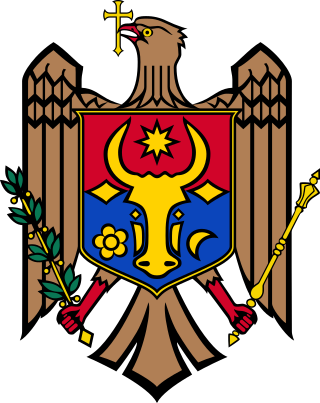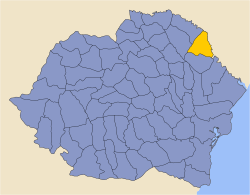
Bessarabia is a historical region in Eastern Europe, bounded by the Dniester river on the east and the Prut river on the west. About two thirds of Bessarabia lies within modern-day Moldova, with the Budjak region covering the southern coastal region and part of the Ukrainian Chernivtsi Oblast covering a small area in the north.

The Moldavian Soviet Socialist Republic or Moldavian SSR, also known as the Moldovan Soviet Socialist Republic, Moldovan SSR, Soviet Moldavia, Soviet Moldova, or simply Moldavia or Moldova, was one of the 15 republics of the Soviet Union which existed from 1940 to 1991. The republic was formed on 2 August 1940 from parts of Bessarabia, a region annexed from Romania on 28 June of that year, and parts of the Moldavian Autonomous Soviet Socialist Republic, an autonomous Soviet republic within the Ukrainian SSR.

Bender or Bendery, also known as Tighina, is a city within the internationally recognized borders of Moldova under de facto control of the unrecognized Pridnestrovian Moldavian Republic (Transnistria) (PMR) since 1992. It is located on the western bank of the river Dniester in the historical region of Bessarabia.

Moldova is divided administratively into two levels:
The history of the Jews in Bessarabia, a historical region in Eastern Europe, dates back hundreds of years.

The Moldavian Autonomous Soviet Socialist Republic, shortened to Moldavian ASSR, was an autonomous republic of the Ukrainian SSR between 12 October 1924 and 2 August 1940, encompassing the modern territory of Transnistria as well as much of the present-day Podilsk Raion of Ukraine. It was an artificial political creation inspired by the Bolshevik nationalities policy in the context of the loss of larger Bessarabia to Romania in April 1918. In such a manner, the Bolshevik leadership tried to radicalize pro-Soviet feelings in Bessarabia with the goal of setting up favorable conditions for the creation of a geopolitical "place d'armes" (bridgehead), in an attempt to execute a breakthrough in the direction of the Balkans by projecting influence upon Romanian Bessarabia, which would eventually be occupied and annexed in 1940 after the signing of the Molotov–Ribbentrop Pact.

A municipiu is a level of administrative subdivision in Romania and Moldova, roughly equivalent to city in some English-speaking countries.

Lăpușna County was a county in the Kingdom of Romania between 1925 and 1938 and between 1941 and 1944.

The Bessarabian Bulgarians are a Bulgarian minority group of the historical region of Bessarabia, inhabiting parts of present-day Ukraine and Moldova.

This is the history of Transnistria, officially the Pridnestrovian Moldavian Republic (PMR), an unrecognised breakaway state that is internationally recognised as part of Moldova. Transnistria controls most of the narrow strip of land between the Dniester river and the Moldovan–Ukrainian border, as well as some land on the other side of the river's bank.

The Metropolis of Chișinău and All Moldova, also referred to as the Moldovan Orthodox Church, is an autonomous metropolitanate under the Russian Orthodox Church. Its canonical territory is the Republic of Moldova.

A demographic history of Transnistria shows that Transnistria has been home to numerous ethnic groups, in varying proportions, over time.

Official statistics of the Pridnestrovian Moldavian Republic, or Transnistria, show that 91 percent of the Transnistrian population adhere to Eastern Orthodox Christianity, with 4 percent adhering to the Catholic Church. Roman Catholics are mainly located in Northern Transnistria, a region with a notable Polish minority.

Bălți is the second largest city in Moldova. It is located in the northern part of the country, within the historical region of Bessarabia, with which the city's own history is closely intertwined.

Orhei was a county in the Kingdom of Romania between 1925 and 1938, and again between 1941 and 1944, with the seat at Orhei.
This article discusses the administrative divisions of the Kingdom of Romania between 1941 and 1944. As a result of the Soviet occupation of Bessarabia and Northern Bukovina, Second Vienna Award and the Treaty of Craiova, territories that had previously been part of Romania were lost to the Soviet Union, Hungary and Bulgaria respectively. By September 1940 the administrative system set up in 1938 based on 'ținuturi' (regions) was disbanded and the former counties (județe) were reintroduced.

Cahul County was a county of the Kingdom of Romania between 1925 and 1938 and between 1941 and 1944, in the historical region of Bessarabia, the successor of Cahul County.
The Moldovan resistance during World War II opposed Axis-aligned Romania and Nazi Germany, as part of the larger Soviet partisan movement. The Moldavian Soviet Socialist Republic (MSSR), presently Moldova, had been created in August 1940 after a Soviet annexation, and liberated by Romania during Operation Barbarossa. Moldovan resistance straddled across a new administrative border: in 1941–1944, Bessarabia was reincorporated within Romania as a semi-autonomous governorate, while areas across the Dnister were administered into a separate Transnistria Governorate. Shortly after the German–Romanian invasion of June–July 1941, the Communist Party of Moldavia (PCM) ordered the creation of a partisan network. The order was largely ineffective in creating an organized movement due to the rapid disintegration of Soviet territorial structures in Bessarabia. Some early organizers opted to abandon their posts, and Soviet attempts to infiltrate experienced partisans across the front line were often annihilated by the Special Intelligence Service. Nevertheless, partisan formations were still able to stage large-scale attacks on the Romanian infrastructure, at Bender and elsewhere. While Romanian documents identified categories of locals influenced by communist ideas as a passive component of the resistance, various modern commentators point to the overall unpopularity of communism in Bessarabia as accounting for the movement's marginality.

The Bessarabia Governorate was an administrative unit of Romania during World War II.


















